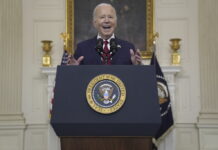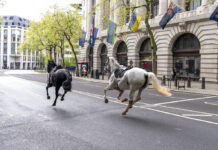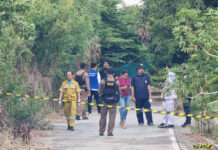BANGKOK — A student play set off the 1976 massacre at Thammasat University 40 years ago today after a photograph of it whipped up a blood frenzy by the media and military.
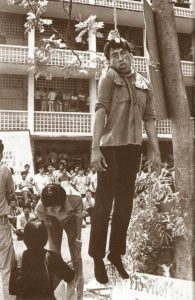
Like many culturally traumatic moments, the slaughter in which the arts played an unwitting, enabling role has since inspired works attempting to understand, interpret or simply keep its memory alive.
After the 1973 uprising ended a decade of military dictatorship, university students’ influence in politics surged with a sharp turn to the left. Only three years later, they were put in check, socially sanctioned and stigmatized as Communists by the right-wing, ultranationalist status quo.
Read: The Will to Remember: Survivors Recount 1976 Thammasat Massacre 40 Years Later
Eventually they were dehumanized to the extent that murdering them was endorsed by the loudest parts of society. The resulting carnage carried out by state-backed militias, police and paramilitary forces on Oct. 6 was shown to the world through photography documenting the massacre.
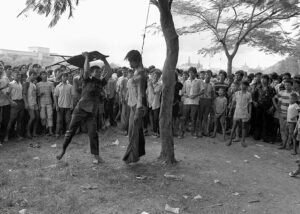
Yet frank discussion about the truth, the facts and myths of what actually happened on that date has been scarce. Instead, the unsettled history’s only reliable forum has been the arts, where artists have tried to shed light on what happened in hope its lessons will be learned.
The following is a look at some of those attempts, recent and historical in different mediums.
Performing Arts
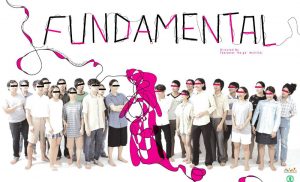
When it comes to approaching political issues through the performing arts, B-Floor Theatre has been at the forefront for almost two decades. Through a physical performance emphasizing movement, visuals and haunting sound, its recent production Fundamental successfully portrayed an abstraction of the tragic incident in a never-ending loop of violence between human beings. The play ran from Sept. 14 through Oct. 2. Despite being informed that some military may visit the performance like the 2015 “Bang La Merd,” no officer shown up.
At dawn this morning, exactly 40 years after the violence broke out, the troupe staged the final performance right where it happened on the Tha Prachan campus of Thammasat University.

After telling the story of former Thammasat University rector Puey Ungpakorn in “Dragon’s Heart the Musical” in August, Anatta Theatre Troupe chose to represent the massacre through the bad memories of a lonely bride and forgetful groom who reunite again after 40 years in “A Nowhere Place” from Sept. 22 through Oct. 6.
Puey, a democratic icon and national hero whose life ended disgraced and in exile, was also the subject of a production by KonNaKhao, or White Face. The troupe staged a longform mime play last month portraying his life in “NaiKhem JaiDee,” a pseudonym he used as a member of the resistance movement against Japanese occupiers and again in a letter to dictator Thanom Kittikachorn. The cheerful nature of the pantomiming and colorful costumes couldn’t mask the cruel facts within.

Puppetry was no longer child’s play in “Little Red in the Ruins,” which presented the dark side of human beings and how they marginalize those who look or think differently. Although ended since Sept. 17, the play will be restaged later this year.
Literature
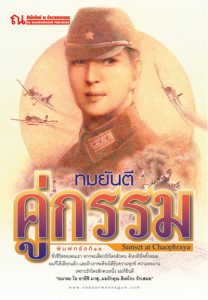
Among writers of that period, a renowned National Artist played an undeniably important role. Vimol Siripaiboon, aka Thommayanti, represented the Army’s Housewives Society in radio speeches against the student protesters. To this day, the ultraroyalist is unrepentant for any role she played. “My only mistake was loving my country,” she once said.
Her conservative ideology shows in her work. In the literary world of 1969’s “Khu Kam (Sunset at Chao Phraya),” a Japanese invader during World War II is the heroic corner of a love triangle, while the nobility of blue blood was praised in her romantic novel “Som Song Saeng (The Moon Shines).”
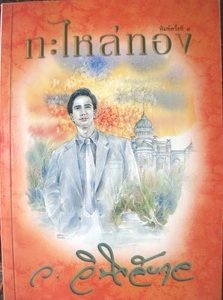
More writers however have approached the massacre in a different perspectives as to satirize with current turmoil.
In 1994, Winita Ditheeyont aka Wor Winichaikul wrote about a writer arrested after the massacre on suspicion of being a Communist. Her novel, ““Kalai Tong (Golden Coating)”, reflected how the lack of certainty about what happened that day could have consequences for people.
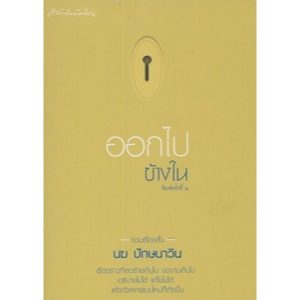
The different reactions of a doctor, youth and a film director to the turbulence, “Psychotherapy Group” was a surreal short story in Nok Paksanawin’s 2014 collection “Ork Pai Khang Nai (Go Out Inside),” which massacre survivors honored with an award 10 years ago on the 30th anniversary.
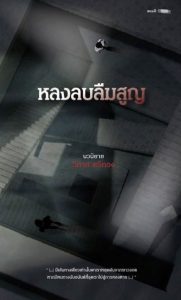
In “Long Lob Leum Soon (Vanishing),” a 2015 novel by Wipas Srithong, characters groped for the exit to a labyrinth as a metaphor for the memories and injustices of past historic .
Visual Arts
There are few examples in the visual arts, although an annual art award is given each year in the name of Manus “Daeng” Siangsing, an artist killed in the massacre.
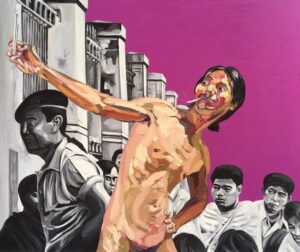
Chumpol Kamwanna’s “Selfie Series” took 10 iconic images from the day and painted in a man taking selfies. The artist sought to comment on the present generation’s disinterest in the history in favor of narcissistic self-obsession. The exhibition runs through Oct. 30 at the People’s Gallery in the Bangkok Art and Culture Centre.
Film
In the years after the massacre, most films to portray it were bare propaganda supporting the state’s version of events.
The Thai Film Archive has collected historical newsreels, including one made by the military, which conveyed the students as malicious Communists who needed to be put down. The reel ends with a triumphant crowd gathered near the King Rama V Monument singing “Naak PhanDin (Scum of the Earth).”
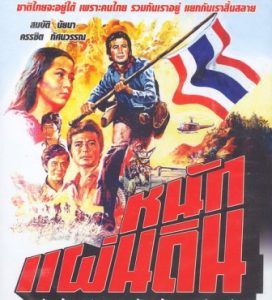
“Naak PhanDin“ was also the name of a 1977 drama which followed Village Scouts in their heroic quest to protect nation, religion and monarchy from degenerates.
In the same year, the film “Kao Yod (Nine Pillars)” used military propaganda footage to portray the protest as anti-democratic.
More recently, “Blue Sky Of Love,” earned 11 million baht in 2008 despite criticism it trivialized the tragedy. In the film, students accidentally join the Communist Party of Thailand and end up in the woods, where they realize true happiness doesn’t come from political ideology.
The horror of the day has also made the leap into the expected genre. In 2009 “Mahalai Sayongkwan (Haunted University)” recounted university campus ghost stories, including “Red Lift,” a chapter about a haunted elevator in which students were shot dead.
More seriously, Pattaraphon Phoothong interviewed parents of two students killed for “Silenced I Memories,” a 2014 documentary. Their tales conveyed the suppressed, tragic truth without resorting to footage of the actual massacre.

